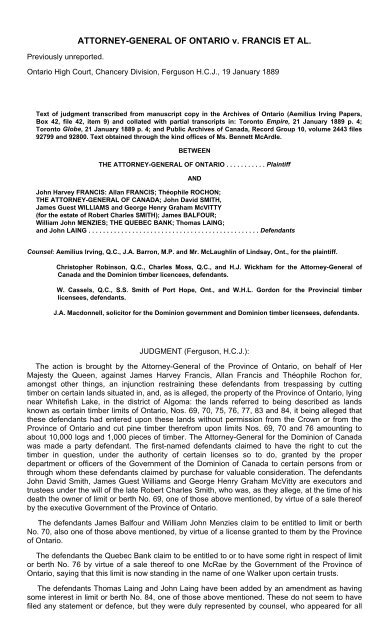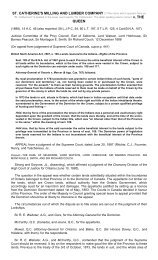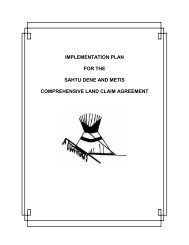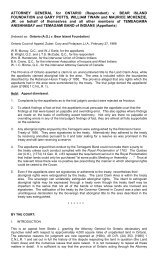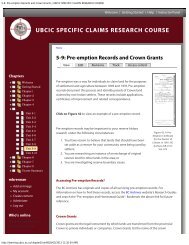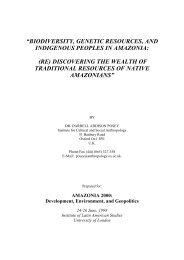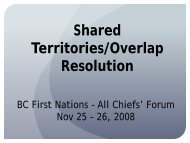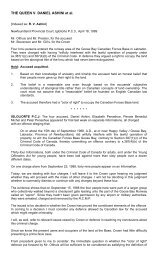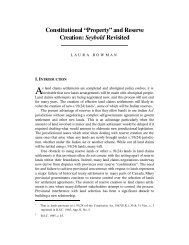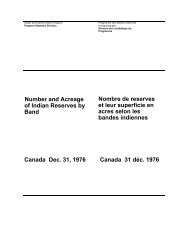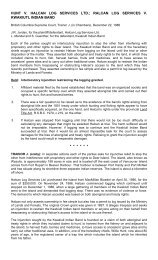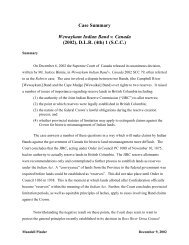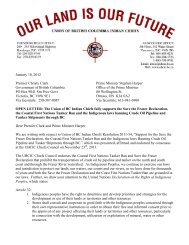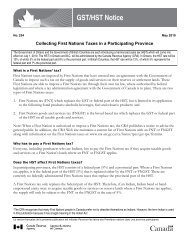ATTORNEY-GENERAL OF ONTARIO v. FRANCIS ET AL.
ATTORNEY-GENERAL OF ONTARIO v. FRANCIS ET AL.
ATTORNEY-GENERAL OF ONTARIO v. FRANCIS ET AL.
- No tags were found...
Create successful ePaper yourself
Turn your PDF publications into a flip-book with our unique Google optimized e-Paper software.
Previously unreported.<strong>ATTORNEY</strong>-<strong>GENER<strong>AL</strong></strong> <strong>OF</strong> <strong>ONTARIO</strong> v. <strong>FRANCIS</strong> <strong>ET</strong> <strong>AL</strong>.Ontario High Court, Chancery Division, Ferguson H.C.J., 19 January 1889Text of judgment transcribed from manuscript copy in the Archives of Ontario (Aemilius Irving Papers,Box 42, file 42, item 9) and collated with partial transcripts in: Toronto Empire, 21 January 1889 p. 4;Toronto Globe, 21 January 1889 p. 4; and Public Archives of Canada, Record Group 10, volume 2443 files92799 and 92800. Text obtained through the kind offices of Ms. Bennett McArdle.B<strong>ET</strong>WEENTHE <strong>ATTORNEY</strong>-<strong>GENER<strong>AL</strong></strong> <strong>OF</strong> <strong>ONTARIO</strong> . . . . . . . . . . . PlaintiffANDJohn Harvey <strong>FRANCIS</strong>: Allan <strong>FRANCIS</strong>; Théophile ROCHON;THE <strong>ATTORNEY</strong>-<strong>GENER<strong>AL</strong></strong> <strong>OF</strong> CANADA; John David SMITH,James Guest WILLIAMS and George Henry Graham McVITTY(for the estate of Robert Charles SMITH); James B<strong>AL</strong>FOUR;William John MENZIES; THE QUEBEC BANK; Thomas LAING;and John LAING . . . . . . . . . . . . . . . . . . . . . . . . . . . . . . . . . . . . . . . . . . . . . . . DefendantsCounsel: Aemilius Irving, Q.C., J.A. Barron, M.P. and Mr. McLaughlin of Lindsay, Ont., for the plaintiff.Christopher Robinson, Q.C., Charles Moss, Q.C., and H.J. Wickham for the Attorney-General ofCanada and the Dominion timber licencees, defendants.W. Cassels, Q.C., S.S. Smith of Port Hope, Ont., and W.H.L. Gordon for the Provincial timberlicensees, defendants.J.A. Macdonnell, solicitor for the Dominion government and Dominion timber licensees, defendants.JUDGMENT (Ferguson, H.C.J.):The action is brought by the Attorney-General of the Province of Ontario, on behalf of HerMajesty the Queen, against James Harvey Francis, Allan Francis and Théophile Rochon for,amongst other things, an injunction restraining these defendants from trespassing by cuttingtimber on certain lands situated in, and, as is alleged, the property of the Province of Ontario, lyingnear Whitefish Lake, in the district of Algoma: the lands referred to being described as landsknown as certain timber limits of Ontario, Nos. 69, 70, 75, 76, 77, 83 and 84, it being alleged thatthese defendants had entered upon these lands without permission from the Crown or from theProvince of Ontario and cut pine timber therefrom upon limits Nos. 69, 70 and 76 amounting toabout 10,000 logs and 1,000 pieces of timber. The Attorney-General for the Dominion of Canadawas made a party defendant. The first-named defendants claimed to have the right to cut thetimber in question, under the authority of certain licenses so to do, granted by the properdepartment or officers of the Government of the Dominion of Canada to certain persons from orthrough whom these defendants claimed by purchase for valuable consideration. The defendantsJohn David Smith, James Guest Williams and George Henry Graham McVitty are executors andtrustees under the will of the late Robert Charles Smith, who was, as they allege, at the time of hisdeath the owner of limit or berth No. 69, one of those above mentioned, by virtue of a sale thereofby the executive Government of the Province of Ontario.The defendants James Balfour and William John Menzies claim to be entitled to limit or berthNo. 70, also one of those above mentioned, by virtue of a license granted to them by the Provinceof Ontario.The defendants the Quebec Bank claim to be entitled to or to have some right in respect of limitor berth No. 76 by virtue of a sale thereof to one McRae by the Government of the Province ofOntario, saying that this limit is now standing in the name of one Walker upon certain trusts.The defendants Thomas Laing and John Laing have been added by an amendment as havingsome interest in limit or berth No. 84, one of those above mentioned. These do not seem to havefiled any statement or defence, but they were duly represented by counsel, who appeared for all
the defendants interested under licenses issued by the Government of the Province of Ontario.One does not readily perceive any sufficient reason for making persons claiming under licensesfrom the Government of Ontario parties defendant in the action, for it could scarcely have beenexpected that in matters of so great importance as are involved in the action substantial andmaterial relief could properly be granted in favor of some defendants against other defendantswithout any pleadings between them or any specific issues being raised by one or any of themagainst the other or others of them, and so far as any of the defendants might appear to beentitled to any relief against the plaintiff, this could not be obtained in this action, or, as wascontended, and I think rightly, in any way except by a petition of right.Besides the relief that I have already mentioned, the plaintiff asks that it may be declared thatthe defendants, the Francis's and Rochon, have no legal rights in respect of the timber cut fromand on any part or portion of the area covered by the above-mentioned timber limits, and that thetimber that had been cut should be delivered up to the plaintiff, also an injunction against theremoval of the same as well as an order for the payment of the damages alleged to have beensustained.The plaintiff asks, in addition to the foregoing, that the defendant by the Attorney-General of theDominion of Canada may be restrained from laying out or interfering with the lands as the reservefor the Indians on the timber limits before mentioned, or any part thereof, and that the true localityof the Indian reserve described by the treaty, mentioned in the second paragraph of the statementof claim, be declared, and such directions given as may be thought proper.This treaty was made with the Indians inhabiting the eastern and northern shores of LakeHuron, from Penetanguishene to Sault Ste. Marie, and thence to Botchewaning Bay, on thenorthern shore of Lake Superior, together with the islands in these lakes opposite to the shoresthereof, and inland to the height of land which formed the southern boundary of the territorycovered by the charter of the Hudson's Bay Company, whereby the whole of such territory, saveand except the reservations set forth in the schedule to the treaty annexed, was surrendered andceded to Her Majesty, Her Heirs and Successors forever. This treaty was made in the year 1850,and is known as the "Robinson-Huron Treaty", the representative of Her Majesty in the treatyhaving been the late Honorable William B. Robinson.The treaty was signed and executed by Mr. Robinson and a large number of chiefs and headmen of the Indians, and in the schedule are mentioned seventeen reserves or reservations tochiefs and their respective bands of Indians. It provides that these reservations should be heldand occupied by the chiefs and their tribes, in common for their own use and benefit, and thatshould the chiefs and their respective tribes at any time desire to dispose of any such reservationsor of any mineral or other valuable productions thereon, the same should be sold or leased at theirrequest by the Superintendent-General of Indian Affairs for the time being, or other officer havingauthority so to do, for their sole benefit and to their best advantage.The reserve mentioned in the plaintiff's statement of claim and in respect of which the presentdifficulty and contention seems principally to have arisen, is the one No. 6 in this schedule and isthus mentioned therein: "Sixth, Shawenakishick and his band, a tract of land now occupied bythem and contained between two rivers, called Whitefish and Wanabitaseke, seven miles inland."Other than this there does not seem to have been at the time any other or further description ofthis reserve, and the others of the seventeen reserves are mentioned or described in the scheduleto the treaty in a manner somewhat similar, if not in the same manner, or at all events with greatbrevity. The evidence shows that it was intended and that it was promised to the Indians that thereserves should soon after the treaty be surveyed by the Crown and their true boundaries markedout, and I think it sufficiently appears that it was understood that when the Crown surveyors weresent for the purpose of making the surveys, the Indians were to point out and show to them thelands that they claimed and had claimed as such reservations.Many years ago these reserves were surveyed by the Crown, as was contemplated, exceptingthis one, No. 6 in the schedule and, as was stated at the trial, another one. The reason why all thesurveys were not completed at the same time does not appear in the evidence, but it was said thatthe survey stopped before completion for a reason personal to the Crown Surveyor who wasengaged in the work.In the year 1872 the Executive Government for the Province of Ontario, for the purposes oftimber sales in the region or tract ceded by the above-mentioned treaty, projected on a plan intoan area of six square miles each, berths which were numbered and sold according to theregulations prescribed by the Government of the province on the 15th day of October in that year,and among others then sold were the several berths aforesaid and in pursuance of such saleslicenses to cut timber on the timber berths were in consideration of certain payments, and to
continue to force for one year, issued to the purchasers by the Crown Land Department of theprovince, and it is not disputed that these licenses have been renewed every year since, either bythe purchasers or those to whom the licenses have been assigned, according to the provisions ofthe statutes in that behalf.Early in the year 1884 the Dominion Government caused a survey of this Reserve No. 6 to bemade by Mr. Aubrey [sic], a provincial land surveyor.In July, 1886, the same Government obtained from the Indians through their chief and headmen or principal men, a deed whereby they surrendered, released and quitted claim to HerMajesty the Queen, her heirs and successors forever all and singular the whole of themerchantable timber on the reserve in trust, to be sold for the joint benefit of the band on suchterms and conditions as to Her Majesty's Government of Canada should seem proper, and astherein mentioned and on the 14th of October, 1886, the timber licenses were issued by theDominion Government. These have been regularly renewed, according to law, and the licensesunder the authority of which the defendants Francis' and Rochon were professing to act in cuttingthe timber on this Reserve. They had been assigned in the mean time by the original licensees butI need not, I think, say anything further as to this.The plaintiff, in the statement of claim, complains that although the sales made by the OntarioGovernment in 1872 had been widely advertised, and plans of the territory and berths thereondistributed showing that the berths covered the territory now claimed by the Government ofCanada as Reserve No. 6, yet that no notice was given by the Superintendent-General of IndianAffairs, or by anyone on behalf of the Government of Canada to the Crown Land Department ofOntario, of any reservation being required within that area for the Indians, or of any Indianreservation or of any right to lay out such reservation, and that no action was taken by the IndianDepartment or the Government of Canada for twelve years or thereabouts after the sales made bythe Province of Ontario. The argument based upon this complaint does not go the length ofasserting that any right additional to the rights such as they were was gained by what had beendone by the Ontario Government and what was said to have been left undone by the IndianDepartment of the Dominion Government, and it was somewhat difficult for me to see why thecontention was raised at all.The evidence of Mr. Vankoughnet, a gentleman who has been 28 years in the IndianDepartment of the Government, and the correspondence between that department and theDepartment of Crown Lands at Toronto seem to put the matter in this shape. The Department atOttawa were not aware that the Crown Land Department at Toronto had made the sales of theselimits till long after the fact; that the knowledge of the fact was gained accidentally; that before anysale was made by the Dominion Government of this timber, or, rather, the licenses to cut it, theIndian Department had communicated with the Crown Land Department of the Government ofOntario; that, in consequence of not having received an answer to a certain letter on this subject,Mr. Vankoughnet, acting for the Indian Department, endeavored to see the Commissioner ofCrown Lands at Toronto but failed in so doing at the time, but had instead an interview with theDeputy Commissioner on the subject, who said it was a mistake to sell the timber on the reserve.Mr. Vankoughnet, in his evidence, says that Mr. Johnston, the Deputy Minister of Crown Lands,said it was a mistake of some of the officers of the department in not having noticed the reserve onthe plans; that he asked him what he proposed doing, and the answer was to the effect that theProvincial Government would have to settle with the purchasers of the licenses. The witnessfurther says: "I think he said he would bring the matter before the commissioner." He also saysthat he came from Ottawa to Toronto expressly for the purposes of this interview.The letter of the 27th August, 1886, refers to this interview. It seems to me that what reallyappears is that, after this interview, Mr. Vankoughnet thought that the Ontario Government wouldsimply settle for the consequences of the mistake, and that the department, of which he was thedeputy superintendent, in this view proceeded to a sale of the timber, or the right to cut the timber,a surrender of which had been obtained by the Dominion Government from the Indians, and Irepeat that I do not see why there was so much contention on this subject. I do not see that eitherGovernment was in a position to blame the other in the matter. I do not see that this or the contraryof it would make any difference in regard to the rights to be determined.As the locality of the reserve had to be determined, and as it had to be found as a fact whetheror not the cutting of timber complained of had taken place upon the reserve, it was thought forvarious reasons that it would be convenient to take the evidence of the Indian witnesses at or nearthe place in question, and this evidence was so taken.During the time of the taking of the evidence I was led to think that the only question to bedetermined between the contending parties was as to whether or not the timber, the cutting ofwhich was complained of, had been cut upon land outside of the boundaries of the reserve, it
eing, as I thought, conceded that if it had been cut upon the reserve the cutting was done underproper authority so to do, but if done upon land not part of the reserve, it was wrongly done withoutany authority. These statements were certainly more than once made by counsel. Upon the finalargument, however, counsel dissented from this as being the sole matter and contended thatwhether the cutting was done upon the reserve or not the property in the land and timber being (aswas contended) vested in the Ontario Government, the cutting complained of was wrongful andcould not be justified under any licenses issued under the authority of the Dominion Government.The plaintiff asks, as I have said, that the true locality of this reserve should be declared. This is oris similar to asking for a declaration of right, and my duty in this respect is to fix the boundaries ofthe reserve as well as I can upon the evidence.The words in the schedule of the treaty are certainly very meagre for this purpose. I may firstdispose of the concluding words "seven miles inland" by saying that after hearing the evidencethat was given in regard to the Indians' understanding, or rather want of understanding, of themeaning of the word "mile"; and general evidence as to the locality that was occupied by this bandof Indians at the date of the treaty; and as to the distance of any part of the locality so occupiedfrom the main waters; and the evidence as to the word in their language used by themindiscriminately to signify the measure of distance or any other measure such, for instance, as abushel; counsel very properly, I think, abandoned any contention resting upon the use of thesewords. The distance from the main waters to the nearest part of the lands at the time of the treatyoccupied by this band of Indians seems to have been more than twice seven miles, but this is notto make any difference.In taking the evidence for the purpose of ascertaining the meaning of the Treaty so far as itrelated to the rights and interests of this band of Indians, evidence was given and receivedrespecting the preliminary facts and instructions to the agent or plenipotentiary of and on behalf ofthe Government (the Crown). Evidence was offered respecting the preliminary facts on the otherside: that is to say, the instructions that were given to the chief of the band, Shewanakishick, bythe Council of his band convened for the special purpose of such instructions; that is, instructionsas to what territory he was to claim as being in the occupation of the band and to which theyshould be entitled as a reserve. Such evidence was objected to, but was received subject to theobjection. I am of the opinion this evidence was properly received, and that the objection to it couldnot be sustained. I think that for this or a like purpose this band of Indians should be consideredas standing in the same position as any other high contracting power or government, and it is aproposition of law that if an agent of a government exceed his authority, the principal is not bound.For this reason I think both the instructions and the contract must be seen in such a case. (1) Storyon Agency, sec. 307a, 8th. Ed., and notes and cases there referred to. By the law of agency at common law there isthis difference between individuals and the government: the former are liable to the extent of the power they haveapparently given their agents while the government is liable only to the extent of the power it has actually given to itsofficers. etc. Besides, it would seem to be improper to receive such evidence on the part of one partyto the contract and not on behalf of the other party. I may here remark that the Indian witnessesappeared to me to give their evidence with a high degree of candour and much intelligence. Theinterpreter was, I think, an excellent one. I did not, with, I think, very careful observation, notice asingle instance in which I was disposed to doubt the veracity of the witness.On the subject to which I have last referred, Mongowin, the chief of the Band, was called and hesaid, "Shewanakishick was my father and the chief before me. I remember my father getting amessage to go to the Sault to see about a reserve for the band. I do not know my own age. I wasgrown up at the time of the message. I remember my father calling a council in consequence ofgetting the message. The meeting was held where I now live at the Whitefish Lake. I was presentat the meeting. My father told the people or asked the people: 'shall I reserve so much', and theyanswered, 'Yes'." Here the objection was interposed, and after it was disposed of the witness said:"I will endeavor to follow the road around the proposed Reserve that was then mentioned". This hedid by mentioning objects and places in the Indian tongue, nine in number. He commenced with:1. Nebenenekahming--which was translated to mean "the place of the high cranberries", aplace known as Cranberry Lake. He says this was mentioned at the council.2. [Anhasahquah(?)]. This is the name of a lake near the house of the Hudson Bay agentimmediately north of Whitefish Lake.3. Mahdahgohming. This is the name of the next lake to the west of the last mentioned one [.]The name means "where the waters stir".4. Koshgo[wee wee]shing. The witness said this was the name of a lake [nam]ed by f[our?]people, and that the waters he had before mentioned run into it.5. Keecheemenessing. This means "great island". The witness says it is in Washkahgahminglake, and that the waters of this Lake flow down to the waters of the Great Lake (Huron).
6. Wah bok tee nong. Which means "[illegible] channel with banks on high hills on each sidecoming near together".7. Pee kee an doh wanahking. This means "an island where there stands a tree having aspreading top", and the lake is called by this name after the tree on the island.8. Kee no gah ming. This means "long lake". The witness says he calls the lake so because itis long.9. Muckohdehwaugohming. This means "black lake". The witness says the water is very black,and that is the reason why he calls the lake by that nameThe witness now says "I have gone around". These nine places are places that surround theterritory that was to be bargained for as a reserve, and he says they were all mentioned at thismeeting of the council of the band, that this piece of land was what his father was instructed by thecouncil to bargain for.He says he went with his father to the Sault and only the two went; the he was present therewith his father and Mr. Robinson, and heard his father say to Mr. Robinson, to put it in thewitness's own words translated, "I have now said as to the marks of the reserve". [Deleted fromMS: "He says he knows why his father wanted this land reserved"]. This witness says he recollectscoming home from the Sault after seeing Mr. Robinson there, but he cannot tell how many yearssince. He says the band of Indians have been using this reserve ever since, and that the firstinterference with them was when the railway was about to be built, when the people weresearching for a good route or track for the road.This witness and others -- amongst whom was the witness Coucroche -- were examined inrespect of the occupation of this piece of land, their sugarbushes, their plantations, their burialgrounds for their dead, their dwellings, etc. The witness Coucroche was the one who seemed tohave the most general knowledge and the best memory as to occupation of places for long periodsfor particular purposes, and as to the places that were actually in occupation by the members ofthe band at the date of the treaty in 1850.I was and I am entirely satisfied that the evidence given by Coucroche and the other witnessesin regard to occupation is true. There is not an agreement in every particular, but there is as nearlythis as one often finds in evidence involving long recollection of witnesses. I think their testimonyremarkably satisfactory in this respect.I find, and I have no hesitation in finding, that the meeting of the Council of the Band was heldas stated by Mongowin, the present chief; that the instructions given by the council toShawenakishick were as he has stated; and that these were stated to Mr. Robinson on theoccasion of the making of the treaty, as stated by this witness.And I am of the opinion, and I find that it is shown by the evidence, that the band at the time ofthe treaty were in occupation (in the way, and the only way, they could in their manner of livingoccupy territory: that is, by their plantations, their sugar bushes, their burial grounds, hunting,fishing, etc.) of the parcel of land embraced by the nine marks -- immovable marks -- mentioned bythe witness Mongowin the present chief; that is, if lines be reasonably drawn from one mark to theother all the way around the tract of land. There was not, of course, occupation of every portion ofthis. I do not think that the proper meaning to be given the word "occupied" in the treaty wouldrequire this. There was actual occupation by members of the band in various parts of this tract,and to include all these by lines reasonably drawn would embrace all the land within the boundaryindicated by the nine marks given by the witness Mongowin; and after hearing all that was said bythe witness, and all the remarks of counsel, one cannot entertain any doubt but that this tract ofland was what these Indians honestly thought they were getting as their reserve, and in myopinion the evidence shows that it is the tract of land they did get as their reserve.I do not feel at all pressed by what was urged respecting certain attempted charts or diagramsshown to have been made by some of the Indians to represent the tract that they claimed as beingtheir reserve. Where I take into account the facts that the only word, as I have before said, thatthese Indians have to signify the measure of distance, is equally applicable to other measures;that they did not and do not yet know what distance is meant by a mile, reckoning, as they do, theirdistances by the length of time occupied in travelling over them, and being unable to express in sodoing fractional parts of a day; together with their manifest inability to make a sketch or diagram torepresent a tract of land; I think it impossible to say that any argument against the present claim ofthese Indians resting upon such a foundation can prevail, even though such charts or diagramsshould apparently differ widely from one really representing what I think has been shown to be thereserve, and any and every argument against the contention of the Indians as to the area of landreally in the reserve, or its location, which is based upon anything they or any of them may have
said or represented in regard to distance or expanse, must give way to the conclusion having itsfoundation upon actual facts ascertained by evidence respecting the immovable objects upon theground. They did not and do not know what is meant by a mile, or a league, or the differencebetween the two measures, nor indeed any measure that to us would be a measure at all.Thus, assuming that the reserve in question is embraced by a line reasonably drawn throughthe nine objects or places that are mentioned and pointed out by Mongowin, the question arises asto where the location is. In my opinion it became entirely plain at the conclusion of the evidenceupon the subject that the survey made by Mr. Abrey for the Dominion Government in the early partof '84 (I think) and the boundary lines laid down by him show the location of this reserve exceptingthat the true boundary on the northerly side or limit is the line of the waters called sometimes"Whitefish River" and sometimes "Whitefish Branch". This line of water is also sufficientlydesignated by the names of objects on the ground that I have before mentioned. The part of Mr.Abrey's survey lying northerly of this line of waters does not, I think, form any part of the reserve.The reason why this area of land was embraced in the survey was shown by the evidence. It isthis: When the survey was being made the agent of the Hudson's Bay Company being there andtaking or feeling some interest in the Indians suggested that they might as well have this piece ofland, as it was in parts better adapted to cultivation such as they do than most of the land in theneighborhood, saying that they might as well have it as not, and that the Government would notobject to it. The Indians, and it appears the surveyor, fell in with the idea and the survey was madeso as to comprehend this piece of ground. From the manner in which other surveys were madelong before this time and soon after the treaty, so far as appears by the report of the same and theevidence and the spirit of liberality that seems to have pervaded the dealings of the Governmentwith the Indians, it can scarcely be doubted that if this piece of land had at an early day, and,perhaps, at any time before the occurrence of the facts giving rise to this contention, been askedby the Indians as part of their reserve it would have been given them. Nevertheless, my findingand decision is that it is not a part of or belonging to the reserve. There is also another point atwhich there is some difference between Mr. Abrey's boundary line and the line reasonably drawnthrough or by the objects or places before alluded to; this difference is however but trifling. Mr.Abrey's line fall[s] at the place inside of the other line, but the Indians are manifestly satisfied toadopt at this place Mr. Abrey's line, and as there is not any material or valuable or substantial, or Imay say appreciable difference, I think that Mr. Abrey's boundary line may reasonably be adoptedat this place.I am of the opinion, then, that Mr. Abrey's survey, varied by making the line of the water that Ihave before mentioned in this connection the northerly boundary, and casting out the part of thesurvey lying northerly of this water line, will show the location and boundaries of this reserve. This,to my mind, has been shown and placed beyond reasonable cavil. This survey has beenmanifested upon a chart or upon charts, and there is a written description of the lands included init, and unless it is considered necessary for the purposes of the Public Records, I do not see anygrave necessity for directing another survey varying this one, as before stated. Counsel in thiscase will be good enough to offer me such suggestions as may occur to them or their clients onthis subject before the formal judgment is drawn up.The next question is as to whether or not any timber was cut by the defendants, licensees, orrather claiming under licenses of the Government of the Dominion outside of the boundaries ofwhat I have determined was and is this Indian Reserve. The answer to this question is that it hasnot been shown by the evidence that these defendants or any of them did by themselves or theiragents cut or remove any timber upon any land lying outside of the boundaries of the reserve as Ihave found and decide such boundaries to be. All the timber cut or removed by these defendants,that appears at all, by the evidence has been shown to have been upon and from the lands of thereserve as I find it to be. None was shown to have been cut upon the lands lying north of the waterline before mentioned and within the boundary laid down by Mr. Abrey in his survey.It was attempted at a late stage of the evidence to show that some dry timber or wood had beencut by these defendants or for them for the purposes of fire wood, upon lands that are not withinthis reserve, but this evidence did not connect these defendants with the cutting of the timber thatwas shown; besides, the evidence of their cutting seems as if it had been hurriedly gathered up,and such cutting of fallen or dry timber for use there or in the neighborhood did not and does notappear to me to be a materially substantial matter within the proper scope or subject of thecontention in this action, although it may be technically so. I am of the opinion that this effortentirely failed.The plaintiff, as I have before said, asks that the true locality of this reserve should be declared.To such a declaration the plaintiff is entitled, and I have endeavored to point out its location and itsboundaries in such a manner that a brief declaration may be readily drawn up answering theplaintiff's request or prayer in that respect.
The findings and conclusions of fact upon the evidence are against what was contended for onbehalf of the plaintiff during the course of the trial, so far as the location and boundaries of thisreserve and the cutting of timber by the defendants who claim under the authority of licensesissued by the Dominion Government are concerned, for what the plaintiff sought to show in regardto the latter was that these defendants had cut timber upon lands not being lands embraced in thisreserve, and hence public lands, belonging to the Province of Ontario, although the fee thereofwas in the Crown, and in regard to the former what the plaintiff sought to show was that thisreserve is not located at all where I decide that it is located, and even if so, that the boundarieswere different from what I decide that they are.It was not at the trial disputed that there was an Indian reserve in this neighborhoodsomewhere, and until the argument (near the close of the argument, I think) it was, as I thought,fully understood that unless the plaintiff succeeded in showing that these defendants had beencutting timber upon lands outside of the boundaries of this reserve, this case against them mustfail. The pleadings of some of the defendants, who claim by virtue of licenses issued by theGovernment of Ontario, seem to place the matter of contention in this way, and until very near theclose of the trial I thought that the only question would be whether or not these defendants had cuttimber outside of the boundaries of the reserve.The plaintiff, however, and as an afterthought, I think, contended, as did also counsel for thedefendants claiming by virtue of licenses from the Ontario Government, that whether the cutting oftimber that was proved or admitted was within or without the boundaries of the reserve the plaintiffwas entitled to succeed, placing the contention on the ground that the property was vested in theProvince of Ontario under the provisions of the B.N.A. Act, and that the Government of theprovince were trustees for the Indians of the amount of money that the Government had receivedfor the timber. I was then of the opinion that this contention could not prevail. These lands areundoubtedly lands reserved for the Indians. The right and power to legislate in regard to theIndians, and lands reserved for the Indians, is clearly given in and by the distribution of legislativepowers made by the B.N.A. Act to the Parliament of the Dominion, which Parliament had and hasthis power and authority.That parliament did during its first session, by 31 Vic., c. 42, legislate in regard to landsreserved for the Indians by providing, amongst many other things, for the manner in which anysurrender of lands by the Indians should be made.From time to time the same Parliament passed various Acts dealing with the subject of theIndians and lands reserved to them. By 39 Vic., c. 18, enacted by the same Parliament, it wasprovided, amongst many other things (sec. 25), that no Indian reserve or portion of a reserveshould be sold, alienated or leased until it had been released or surrendered to the Crown for thepurposes of the Act and by 43 Vic., c. 28, if not earlier, provision was made for granting licenses tocut trees, etc., on the Indian reserves.I am not aware of any objection ever having been made or any unfavorable comment havingbeen spoken or written in respect of such legislation or anything that was done in pursuance of it,and there seems to me to be reason for thinking that it was a view entertained by bothGovernments that the Government of the Dominion had the right and power to legislaterespecting, and to administer the affairs of and appertaining to, the Indians and the lands reservedfor the Indians; there being, however, a difference of opinion as to what lands were "landsreserved for the Indians".As I have said there can be no doubt that in any view of this latter question these lands are andmust be considered lands reserved for the Indians. This cannot be otherwise if there exist anysuch lands at all; and what the Dominion Government did by obtaining a release or surrender ofthis timber (the timber upon this reserve) and issuing licenses for the cutting of it, the moneyarising to be for the benefit of the Indians, appeared to me to be a simple act of administration ofthe affairs of this little band of Indians and the lands reserved to them, done in pursuance of or inaccordance with the legislation on the subject which the Dominion Parliament seemed to me tohave the undoubted power to enact, and in accordance with the idea expressed in the Treaty of1850. See the remarks of Mr. Justice Patterson in The Queen v. St. Catharines Co., (1886), 13O.A.R. 148 at 173.For these and the like reasons I was at the close of the argument of the opinion that theDominion Government had the power and authority to do as they did, and that the defendantsclaiming under such licenses from the Dominion Government were justified in cutting the timberthat they did cut upon this reserve, and that it was a matter with which the Province of Ontario hador has at the present time no concern, no matter what might be considered to be the right that
would arise, if any, to the province upon the lands of this reserve being ceded by the Indians to theCrown, or the reserve becoming wholly unnecessary by reason of the bands of Indians becomingextinct, etc.I then thought that the relief that the plaintiff should have was the declaration as to the reserveand its boundaries to which I have before referred, and that, in other respects, the action shouldbe dismissed, for I did not see that the defendants claiming under licences from the OntarioGovernment could in this action have any relief against the plaintiff, and I thought that they wereentitled to none against their co-defendants.It was then said, however, that in the case The Queen v. St. Catharines Co., which was pendingbefore the Privy Council upon an appeal, it was likely or probable, from the nature of some of thearguments before that court and some remarks that were reported to have been made by some ofthe learned judges, that there would be an expression of opinion regarding the "quality", as it wascalled, of the Indian title, although that action was upon a subject and in regard to rights orsupposed rights quite different from the matter involved in this action. For this reason thisjudgment has been delayed till the present time.I have now had an opportunity of perusing the judgment of the Privy Council in that action uponthe appeal to them. They have not seen fit to discuss or decide anything as to the quality of theIndian title, considering that unnecessary for the determination of the appeal before the Council;and after a careful perusal of the whole of the judgment, I am of the same opinion as at the closeof the argument. I think the decision does not and cannot affect in any degree in favor of theplaintiff the rights and matters in contention in this action, but, as some of the statements orexpressions in the judgment might be thought at first view to have some bearing upon the mattersof this action, I will refer to these and say very shortly why they have in my opinion no suchbearing.One of these is: "The enactments of section 109 are, in the opinion of their Lordships, sufficientto give to each province, subject to the administration and control of its own Legislature, the entirebeneficial interest of the Crown in all lands within its boundaries which at the time of the unionwere vested in the Crown, with the exception of such lands as the Dominion acquired right tounder section 108, or might assume for the purposes specified in section 117. Its legal effect is toexclude from the 'duties and revenues' appropriated to the Dominion all the ordinary territorialrevenues of the Crown arising within the provinces." The court then refers to Attorney General v.Mercer.This comprehensive language must, in my opinion, be applied to the subject matter of the casethen under consideration. The lands in that case had been ceded to the Crown by the Indians bythe Treaty of 1873, and had thus been disencumbered of the Indian title. If there were doubt as tothis way of looking at or constructing the passage, it is made, I think, plain by the concluding partof that portion of the judgment in which their Lordships decide against the contention on behalf ofthe Dominion Government in respect to the ceded territory, rested on the provisions of section91(24). The passage is: "Their Lordships are, however, unable to assent to the argument for theDominion founded on section 91(24). There can be no a priori probability that the BritishLegislature, in a branch of the statute which professes to deal only with the distribution oflegislative power, intended to deprive the provinces of rights which are expressly given them inthat branch of it which relates to the distribution of reserves and assets. The fact that the power oflegislating for Indians and for lands which are reserved for their use has been entrusted to theParliament of the Dominion is not in the least degree inconsistent with the right of the provinces toa beneficial interest in these lands available to them as a source of revenue whenever the estateof the Crown is disencumbered of the Indian title."In that case the lands in question has been disencumbered of the Indian title, as before stated,by the Treaty of 1873. In the present case the lands have not been ceded and have not been sodisencumbered, besides, the latter part of the passage discloses the view of the court as to theperiod at which the beneficial interest spoken of becomes available to the province as a source ofrevenue, namely, when the estate of the Crown is freed from the Indian title, and seems to me notto consist with the argument before me respecting a trust existing in the Province for the benefit ofthe Indians. Then afterwards the court said: "The treaty leaves the Indians no right whatever in thetimber growing upon the lands which they gave up, which is now fully vested in the Crown, allrevenues derivable from the sale of such portions of it as are situate within the boundaries ofOntario being the property of that province", indicating in addition to what I have before said thatthe Indians had before the treaty or surrender rights in respect of the timber, a consequence ofwhich would seem to be that it may be used by them or for their benefit until such time as their titlebecomes extinguished by cession, surrender or otherwise.A careful perusal of the judgment of the Privy Council shows, I think, that it does not militate in
any degree against the contention of the Dominion Government here, and portions of it indicatethat the Dominion Government is right in legislating for these Indians and their lands (a reservewhich has not been ceded or surrendered in any way) and in administering their affairs in themanner in which they are doing. The rights of the Indians in respect of this land, and the rights thatthey had in respect of the timber thereon, were rights and interests other than that of the provincein the same, to say the very least; and I do not desire to be understood as indicating any opinionas to what, if any, right the province has in respect of such lands.The plaintiff is entitled to the declaration that I have before mentioned, but I am still of theopinion that the action must in all other respects be dismissed, with costs to the defendantsclaiming under licenses of the Dominion Government and to the defendant the Attorney-Generalfor the Dominion Government. I do not see that I can give the other defendants any relief, but I amwilling to hear their counsel on the question of their costs.


